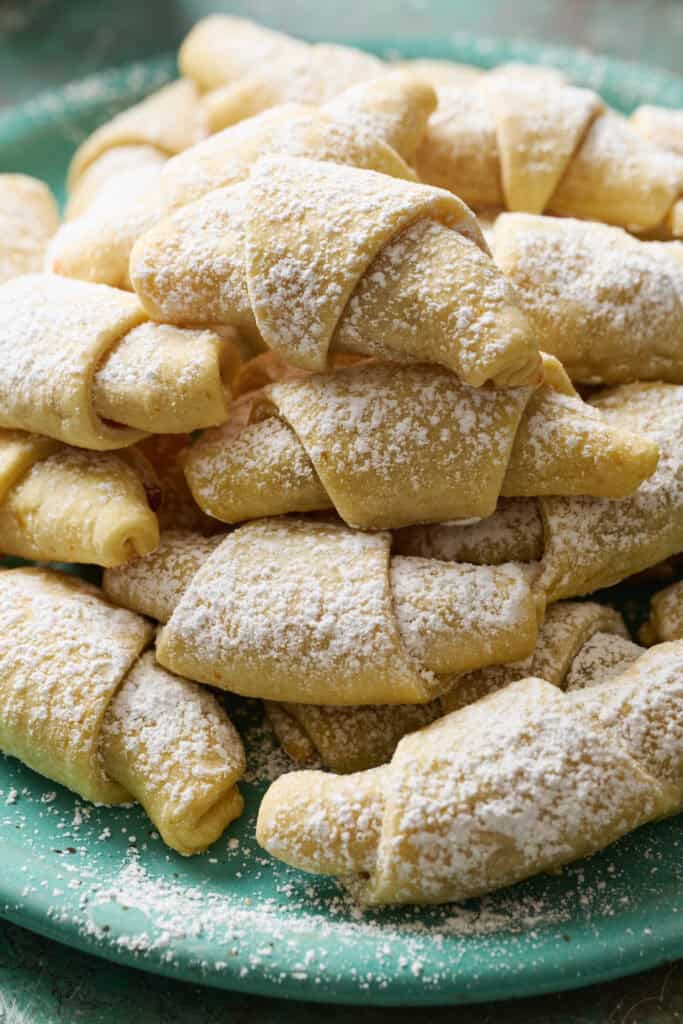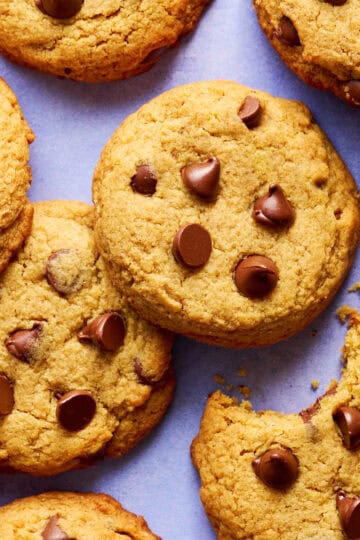Kifle are a traditional crescent-shaped pastry with apricot, raspberry, nut or cheese filling. This recipe has been handed down through the generations and is always a part of our Christmas festivities.

I was introduced to Kifle when I met my husband. His family is of Yugoslavian descent, and you'll find variations on this recipe in Eastern European homes including kifli, kiflice, kifle, or kipferl and its cousin, the kolachi.
There are two components to kifle. The filling and the dough.
Making the Apricot Filling for Kifle
We typically fill our kifle with apricot filling. Some recipes suggest using store-bought apricot preserves. However, store-bought preserves typically have a lot more water in them causing them to run out of the cookies during the baking process.
Our homemade apricot filling in the recipe below isn't too sweet and adds a rich fruity flavor in every bite.

All you need is water, dried apricots and brown sugar.
Start by heating the dried apricots in water. Once they've softened a bit, add in brown sugar and occasionally stir until the fruit starts to fall apart. This takes approximately 20 minutes. From there you can mash up the fruit with the back of your spatula or bust it up with an immersion blender or food processor.
You'll end up with a rich, flavorful, homemade apricot filling.
And good news, this recipe makes more than enough for the cookies. You'll end up with a bit leftover that can be used as jam on toast.





Sulfured versus Unsulfured Dried Fruit
You might notice that the dried apricots I use are a deep orange color. That's because they're unsulfured, meaning they haven't been treated with sulfur dioxide.
Sulfur dioxide is used as a preservative in dried fruits, giving them a bright color, which is great if you want your dried fruit to last a long time. But, I like using unsulfured dried apricots for this filling because they often have a richer, more intense flavor, sometimes described as more "caramel-like" or "earthy" compared to their sulfured counterparts.
Sulfured dried apricots will work just as well for this recipe, but the color will be lighter.

Making the Dough
Kifle dough is easy to make. It doesn't require any fancy equipment, just a bowl, a fork and your hands.
I have seen some recipes suggest using a food processor. However, there's something therapeutic for me when it comes to kneading dough.
The ingredients for the dough are all-purpose flour, active dry yeast, sour cream, salt, butter, egg yolks and vanilla.
The sour cream adds a nice tangy flavor as well as serves as an acid to help activate leavening in these cookies so that they puff up a bit when they're baked.
And note that it calls for egg yolks. You'll want to separate the yolks from the egg whites because including the whites would add too much water to the dough and it won't hold together. The yolks as a nice golden color in addition to extra richness in your final cookies.



Rolling Kifle
Rolling kifle cookies is a skill that improves with practice. There are three things I do that help set me up for success in shaping my kifle.
First, I weigh the dough ball. Then I divide that total weight by 8. That number gives me the weight I should have to divide the dough into 8 equal portions. Each of those becomes a smaller dough ball which makes forming the cookies easier later in the recipe.
Next, you'll cover the dough balls with plastic wrap and let them chill in the fridge for an hour. Not only does this develop the flavor but it also strengthens the proteins in the dough so it holds together better when it comes time to roll it out.
Which brings me to the second thing that will help you rolling. Use a baking mat with measurements. I'm not a big kitchen gadget person, but this mat is an excellent guide for rolling out dough to the right diameter. It also helps me see where to make the cuts in the dough.
And the third tip is something I learned from my mother in law who taught me this recipe. Instead of using flour on the work surface which is typical to prevent dough from sticking, use confectioners sugar or powdered sugar. It helps prevent the dough from sticking, but because it's not an overly sweet cookie, the little added sugar adds nice flavor to the final cookies.

I use a pizza cutter to cut out the rolled dough into eight equal pieces, like a pie.
And then I place a dollop of the apricot filling at the outside edge of a single piece. From there, you'll start rolling from the wide outer edge of the slice toward the center tip, making sure the filling is trapped inside the roll.
Once you get to the tip of the slice, you'll secure the ends of the roll to keep the filling securely inside and then roll the outer edges in slightly to get that signature crescent shape.
Once your kifle are rolled, place them on a baking sheet lined with parchment paper or a silicone liner and bake for 13 to 15 minutes at 375F until they're golden brown and slightly puffed.


Storing and Serving Kifle
Once the kifle have cooled, I place them in an airtight container until I'm ready to serve.
I dust them with powdered sugar right before serving. Wait until serving to add the powdered sugar because it will absorb into the cookies if you do it ahead of time.
The filling is rather tart and there's no sugar in the dough, so the powdered sugar is the little hit of sweetness that takes these treats to the next level.

More Well-Loved Family Recipes
Joanie's Balanced Bites: How to Enjoy Dessert and Balance Blood Sugar
Kifle are a cherished tradition and there's no way I'm skipping them at our holiday festivities. Even though they are made with white flour and cane sugar, that doesn't mean I have to ride the glucose roller-coaster.
The trick is enjoying them as a part of a balanced meal with adequate fiber, fat and protein to blunt the impact of glucose. For example, enjoying them after a meal of:
- A protein-rich main like Christmas Beef Roast or roasted turkey
- A fiber-forward side like roasted green beans or my favorite festive arugula salad
- And one of my go-tos: enjoy your kifle slowly with a cup of coffee or unsweetened tea after the meal. Savoring each bite helps you feel satisfied.
Balanced living includes a healthy dose of Vitamin J (Joy!) while thoughtfully pairing foods so you feel your best.
Browse ➡️ Blood Sugar-Friendly Recipes

Kifle
- Prep Time: 60
- Cook Time: 60
- Total Time: 2 hours
- Yield: 64 cookies
- Category: cookie
- Method: baking
- Cuisine: european
Description
Kifle are a traditional crescent-shaped pastry with apricot, raspberry, nut or cheese filling. This recipe has been handed down through the generations and is always a part of our Christmas festivities.
Ingredients
- 2 ¼ cups (300g) dried apricots
- 1 ½ cups water
- 1 ¼ cups (270g) brown sugar
- 4 cups (500g) flour
- 1 package (2 ¼ teaspoon or 7g) active dry yeast
- 1 cup (240g) sour cream
- ¼ tsp salt
- 1 ¼ cups (284g) butter, room temperature
- 4 egg yolks, room temperature
- 1 tsp vanilla
Instructions
- Place apricots and water in a saucepan and simmer over medium for five minutes until they are soft and have soaked up some of the water.
- Reduce the heat to low, add in the brown sugar, and stir until combined. Then let it continue to simmer for 20 minutes, stirring every 5 minutes, until the apricots are super soft and can be broken up with the back of a spatula.
- Smash up the apricots with your spatula so the jam is somewhat smooth. You can also use an immersion blender or a food processor if you like.
- Once you have a nice thick apricot jam, put it in a bowl and cover it with plastic wrap, and set it aside.
- To make the dough, combine the flour and yeast in a bowl and then add in the butter, cut up into tablespoons. Mix it with a fork to break up the butter until you get a nice gravel-like consistency.
- Add the sour cream, egg yolks and vanilla to the flour and butter mixture and mix with your fingers until fully combined then remove the dough as a large ball and knead on a clean work surface for 3 minutes until smooth. The dough should be soft and easily kneaded.
- Divide the large dough ball into 8 evenly sized pieces and roll each into a ball. Place your dough balls on a tray or plate and cover with a kitchen towel or plastic wrap and refrigerate for 30 minutes.
- Preheat the oven to 375F and line a half-sheet baking pan with parchment paper or a silicone baking mat.
- Take your dough out of the refrigerator and work with one dough ball at a time. Sprinkle powdered sugar on a clean work surface, then place the dough ball on it and roll it out with a rolling pin until ⅛ inch thick.
- Using a knife or pizza cutter, cut the dough into 8 triangular pieces, like a pizza.
- Place a teaspoon-sized dollop of the apricot jam near the edge of the dough on each slice, then roll up the outside over the filling and start rolling in toward the tip of the piece of dough, pinching the sides to seal in the filling.
- Once rolled, place the cookies on the baking sheet and bake at 375F for 13 to 16 minutes until they ever so slightly start to brown.
- Allow to cool on a cooling rack, then sprinkle powdered sugar and serve.
Nutrition
- Serving Size: 1 cookie
- Calories: 80
- Sugar: 2.3 g
- Sodium: 13.4 mg
- Fat: 4.5 g
- Carbohydrates: 8.6 g
- Fiber: 0.3 g
- Protein: 1.3 g
- Cholesterol: 22.3 mg





Did you make this recipe? Let me know!